67% of social advertisers consider Facebook to be the most effective social media platform they use.
At this point, it’s like Google Ads — it’s an essential part of any effective marketing strategy. There was a time when brands could acquire customers organically, but that era is over. Now Facebook is strictly pay-to-play, and advertisers need to go above and beyond boosting a post every so often.
Consider these stats:
- Although the average price for an ad had a 2% decrease, ad impressions grew by 34%
- There are 7 million advertisers on Facebook
- The average cost-per-click on Facebook is $1.72
- The potential reach of advertising for Facebook is 1.9 billion
Publishers on Facebook’s Instant Articles platform have a reason to smile – the social media giant now allows them to include more ads in the “Related Articles” section.
After being called out by ad-dependent publishers on the ad restrictions, Facebook began testing ad units below the Instant Article page in March 2017. Making the announcement on Thursday, Facebook said that the test is now open to all publishers within the network.
Without quoting numbers, Facebook said that the initial test – which involved showing relevant ads to readers on Instant Articles – saw an “incremental increase” in revenue for publishers.
By opening up the tests to all publishers, the company hopes to get more feedback to help it improve the experience.
In 2023, having a solid Facebook Ads plan — and using the right tools to execute it — is more important than ever. That’s why we rounded up the key trends that will impact running ads on Facebook this year.
Book My Free Marketing Consultation
5 Most Important Trends for Facebook Ads
Trend #1: Facebook Ad Costs Will Continue to Rise
Facebook Ads are still pretty affordable for most marketers, but costs are increasing steadily year over year, and many advertisers are justifiably worried.
Why do costs keep going up? It’s a simple matter of supply and demand. Facebook currently has about 7 million advertisers, up from 4 million. But it hasn’t acquired new users to meet that growth, especially in the U.S. and Canada, where daily active users have been flat for a couple of years now.
As Statista shows, this year alone has seen no growth:
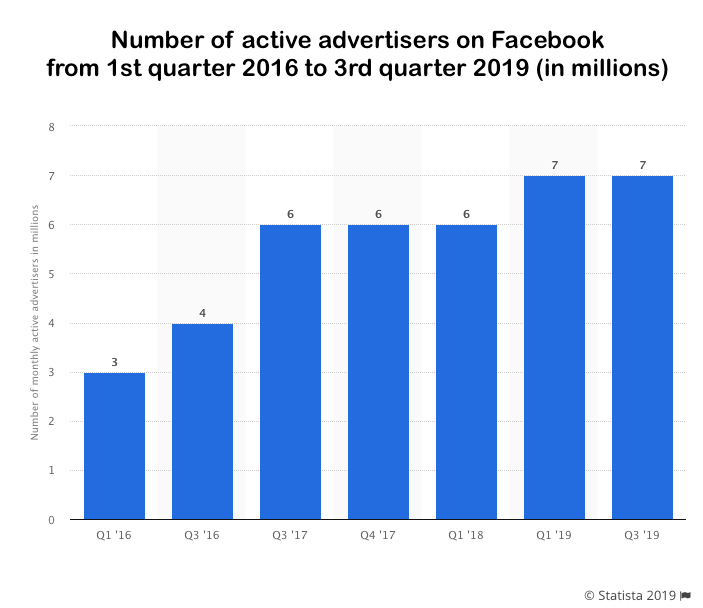
A study of 200 marketers spending $100K on Facebook during October 2019 shows that:
- CPMs on Facebook have grown 90% YoY for marketers, and that number only continues to grow.
- Rising costs are a concern for 85% of marketers, with 13% “extremely” concerned about it.
- That concern is exacerbated since 42% of marketers are spending more than 2018.
- If costs continue to rise, 47% of marketers believe they could be priced out of paid Facebook advertising.
Expect this trend to continue, and to possibly be made worse by competition for eyeballs from political campaigns.
If you’re concerned about the affordability of Facebook Ads, weigh the cost of acquiring new customers against their lifetime value. You’ll probably find that you’re still getting your money’s worth.
Dive Deeper:
* 30 Winning Facebook Ads and Why They’re so Effective
* How to Get the Cheapest Facebook Ads Without Sacrificing Quality
* 11 Ways to Improve Your Facebook Ads Relevance Score
* How to Get the Most Out of Your Facebook Ads Audit
Trend #2: AI, Automation & AR Will Be Used More
Facebook has been investing heavily in artificial intelligence (AI) to help improve the performance of advertising on the platform. Not all of the tools are there yet, but they are worth testing to see if they improve your ROI.
Here are some of the automation tools that are currently available for advertisers:
- Campaign Budget Optimization (CBO): With CBO, you set your budget at the campaign level, rather than the ad set level, and then Facebook uses that along with your bid strategy (lowest cost per action (CPA) or highest return on ad spend (ROAS)) to maximize your spend.
- Automatic Placements: Instead of selecting your placements, Facebook will choose them for you, running your ads on Instagram, Audience Network, and Messenger as well as Facebook and optimizing for cost.
- Dynamic Formats and Ad Creative: If you’re using Dynamic Ads, this machine-learning option delivers a personalized version of the ad to everyone who sees it, based on which ad types they are most likely to respond to. It’s available for the catalog sales, traffic, and conversions objectives. Facebook’s own testing of this ad type found an average of 34% improvement in incremental ROAS, 10% improvement in lift, and 6% lower cost per incremental purchase compared to carousel-only ads.
- Automatic Language Translation: For selected placements and languages, you can choose to have Facebook auto-translate your ad into the user’s preferred language. A caveat: Facebook doesn’t guarantee the quality of automatic translations, so you have to manually review each one.
- Multiple Text Optimization: This feature hasn’t been fully rolled out yet, but it’s available to some users and will initially be available for the traffic, app installs and conversions objectives. You can add five different options for the primary text, headline and description of your ads, and then Facebook will show different combinations of text to users based on what they’re most likely to respond to as identified by machine learning models.
Here are some examples for how you can vary your text with the multiple text optimization:
- Include pricing information that could prompt people to act:
Option 1: All-inclusive services available at low prices!
Option 2: All-inclusive services available for just $19.99!
- Add data to show your business value:
Option 1: Save money by calling us!
Option 2: 80% of new customers save money by calling us!
- Incorporate a quote from a review or testimonial:
Option 1: Our customers call our pizza the best pizza in Seattle.
Option 2: “Literally the best pizza in Seattle.” —Recent customer
Facebook also recently introduced Augmented Reality Ads, which allow users to do things like try on make-up or play games. In the United States, 63% of people have tried an AR experience from a brand, so there’s a huge opportunity there for advertisers on Facebook. For instance, WeMakeUp launched an AR Ad on Facebook that let people “test drive” their new shade of lipstick and saw a 27.6-point increase in purchases:
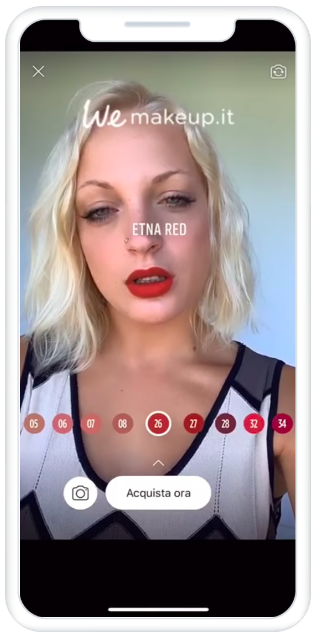
Facebook will be expanding Augmented Reality Ads for more advertisers, with a beta version going global this fall.
Native Ads? Not So Much
While the ads are similar to the normal photo-and-link ads that appear on the News Feed, they aren’t really “native ads,” as Facebook describes them.
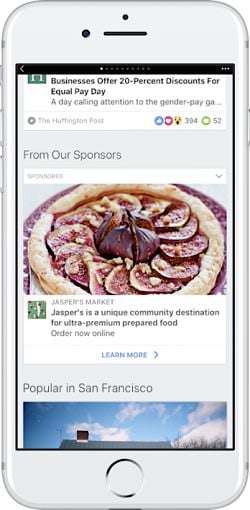
Facebook requires a publisher to be part of Facebook’s Audience Network before they can feature an ad in this section. Once the publisher configures their Instant Articles to feature the ads, they are required to select “Banner” as the ad format.
Dive Deeper:
* What Is Marketing Automation: Definition, Benefits & Uses
* 5 Trends that Will Define the New Vision of Marketing Automation
* What Is Post-Click Automation & Why Should Agencies Offer It as a Service?
* 4 Ways to Use Automation with Account-Based Marketing for Better Lead Nurturing
Trend #3: Mobile-first and Mobile Studio Will Be the Name of the Game
93% of Facebook’s ad revenue comes from mobile advertising, which means: forget desktop if you’re a marketer — mobile-first is the way to go.
The biggest difference between mobile ads and desktop ads is what’s under the image. On desktop, there’s a headline and description, but on mobile, there’s just a URL and headline.
When writing copy for desktop, you need to avoid repetition in the primary text and description — for mobile, you need to make sure all the important info is in the primary text. You also have less real estate to work with on mobile before the “see more” prompt, so you need to hook the user in right away, like in this example:

Another must for Facebook mobile ads is a call-to-action (CTA) button. Ads without buttons result in fewer leads and a higher cost of acquisition. Test results show that not having a CTA button can increase the cost per lead by 2.5X, and any choice of CTA button worked better than having none at all:
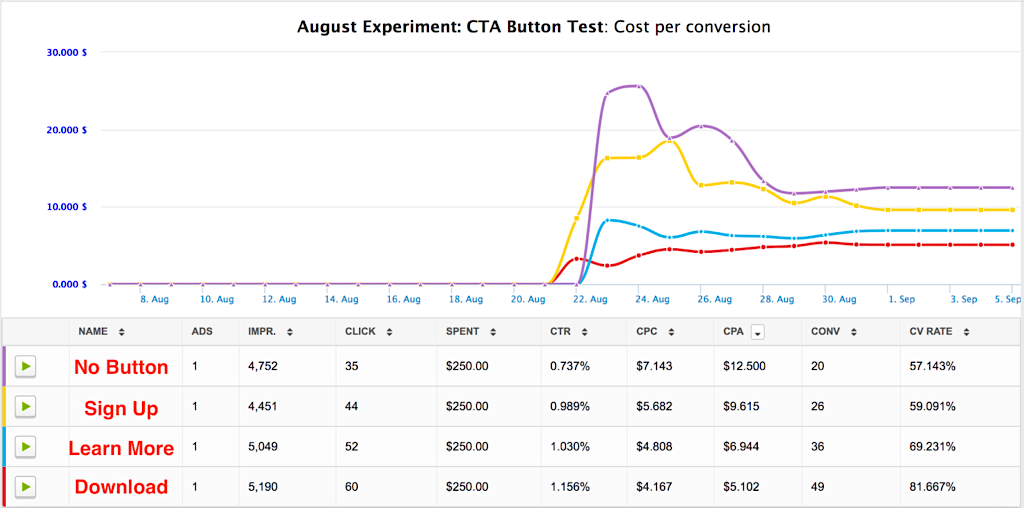
Facebook’s Mobile Studio allows you to create dynamic motion-driven mobile ads from your mobile phone in minutes:

This feature includes easy-to-follow video guides, a downloadable planning brief, and creative app recommendations for advertisers who are just getting started with mobile video ads or want to take their existing ones to the next level.
Recent Tweaks to Instant Articles
At the core, Instant Articles are supposed to make it easier for the reader by showing them only what they want to see. This means allowing them to focus on the text and any accompanying media. However, this hasn’t been going well with most publishers as they depend on the extras to actually make money.
As a result, Facebook has had to look for ways to address the publishers’ concerns while still maintaining the speed and relevance of Instant Articles.
In recent months, the company has allowed publishers to:
- Include more ads: Facebook now permits publishers to place ads every 250 words instead of every 350 words in their articles. This change allows for potentially 20-30% more ad placements per article.
- Use recirculation widgets: Publishers can now add their own recirculation widgets at the bottom of Instant Articles. This feature helps keep readers engaged with the publisher’s content, potentially increasing page views and ad revenue.
- Implement call-to-action units: Facebook has introduced several call-to-action units that publishers can use within Instant Articles. These include email sign-up forms and Page Like buttons, helping publishers build their audience directly from the Instant Articles format.
- Utilize Facebook’s Audience Network: Publishers can now tap into Facebook’s Audience Network to fill their ad inventory, potentially increasing their overall ad revenue.
- Add more visual branding elements: Facebook has expanded the customization options for publishers, allowing them to include more branded content like logos and custom fonts, helping maintain their unique visual identity.
- Implement paywall support: For subscription-based publications, Facebook now supports paywalls within Instant Articles, allowing publishers to maintain their subscription models.
- Access more detailed analytics: Facebook has improved its analytics tools for Instant Articles, providing publishers with more granular data on reader behavior and ad performance.
- Use video ads: Publishers can now include video ads within their Instant Articles, opening up new revenue opportunities.
These changes aim to strike a balance between maintaining the fast-loading, clean reading experience that Instant Articles were designed for, while addressing the revenue concerns of publishers. By offering more flexibility in monetization and branding, Facebook hopes to keep publishers engaged with the platform while still providing a superior reading experience for users.
Trend #4: Video Ads Will Take Center Stage
Video content continues to be a powerful force on social media, including Facebook Ads:

Facebook’s data shows users spend 5 times longer viewing video content compared to static posts in their feed. Video ads are also popular with marketers, with a recent survey showing 63.24% use video ads more often than image ads for their ad strategies:
Key strategies for video ads in 2024:
- Brief videos: As attention spans decrease, 15-second videos are gaining popularity. These shorter ads have shown a 50% higher view-through rate compared to 30-second spots.
- Silent auto-play: 85% of Facebook video is watched without sound. Make your video ads effective even when muted by using captions or text overlays.
- Live video: Facebook Live videos receive 6 times more interactions than regular videos. Think about incorporating live video into your ad strategy.
- 360-degree videos: These immersive videos have demonstrated a 14% higher return on investment compared to traditional video ads.
Trend #5: Personalization and Precise Targeting Will Be Key
As privacy concerns grow and third-party cookies phase out, first-party data and personalization become increasingly important. Facebook’s advanced targeting options allow for highly personalized ad experiences.
Key personalization strategies:
- Custom Audiences: Use your customer data to create precisely targeted audiences.
- Lookalike Audiences: Broaden your reach by targeting users similar to your best customers. Lookalike Audiences have been shown to improve conversion rates by up to 400%:
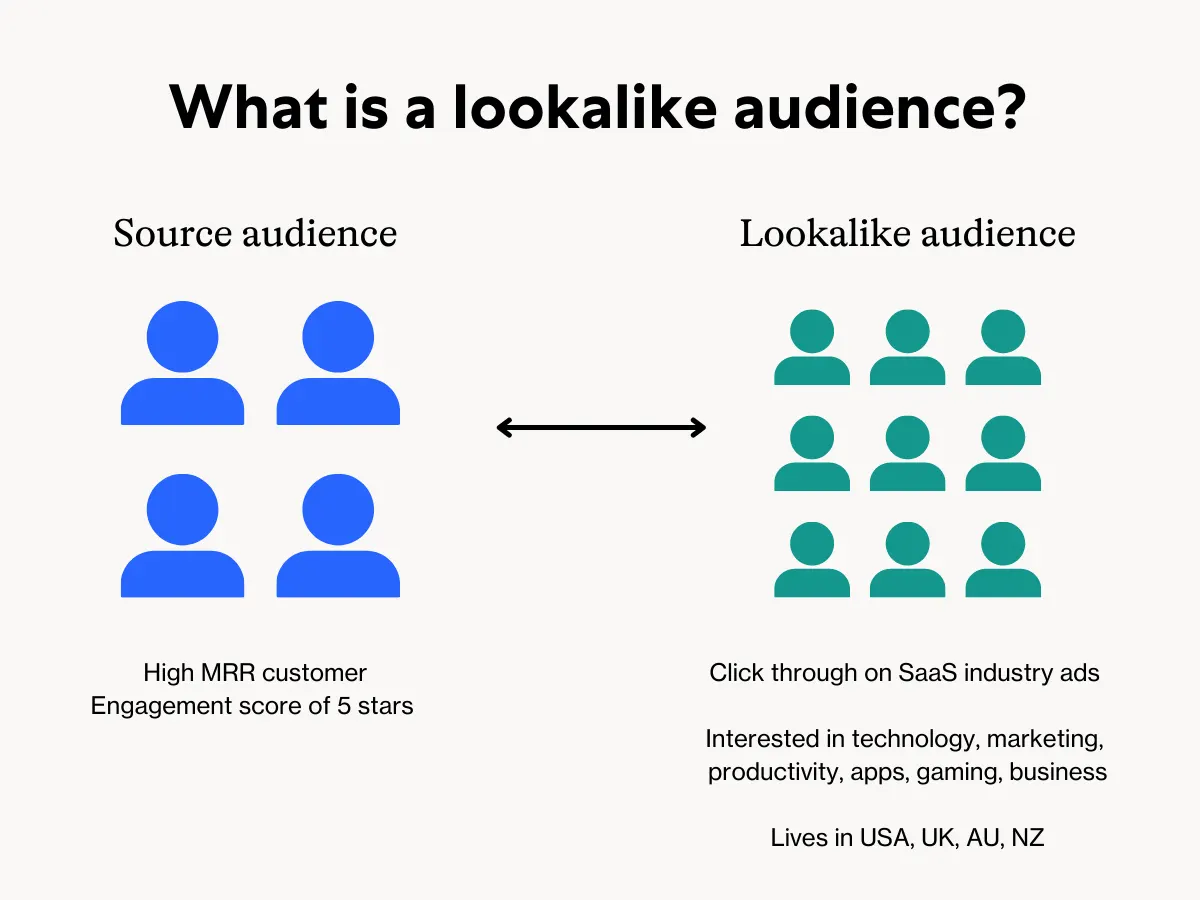
- Dynamic Ads: These ads automatically display the most relevant products to users based on their interests and behaviors.
- Retargeting: Focus on users who have already shown interest in your brand. Retargeted ads have a 10 times higher click-through rate compared to regular display ads.
Remember, with great targeting capabilities comes great responsibility. Always prioritize user privacy and follow Facebook’s advertising policies and data protection regulations.
Final Thoughts on Making the Most of Facebook Ads Trends in 2024
As we look at the changing landscape of Facebook advertising in 2024, it’s clear that keeping up with these trends is vital for marketing success. The rising costs of Facebook ads highlight the need to optimize every campaign for maximum ROI. Using AI and automation tools, focusing on mobile-first strategies, leveraging video content, and fine-tuning personalization are now essential parts of a competitive Facebook ads strategy.
However, it’s worth noting that while these trends offer valuable guidance, they shouldn’t be followed without consideration. Use these trends as a starting point, but always let data guide your decisions. Regularly check your ad performance, be ready to change course when needed, and don’t hesitate to try new approaches.
Finally, as we adopt these technological advancements and targeting capabilities, we mustn’t forget the human element. At its core, effective advertising is about connecting with people, understanding their needs, and providing value. By combining current trends with timeless marketing principles, you’ll be well-positioned to maximize your Facebook ads in 2024 and beyond!






